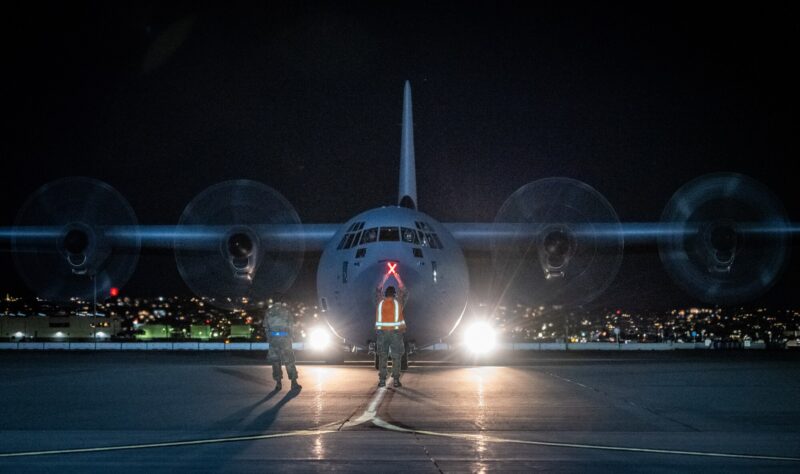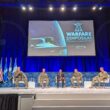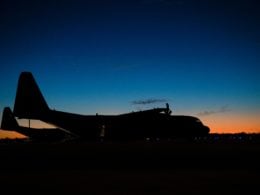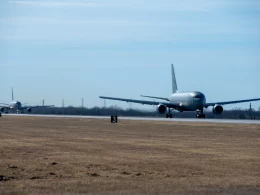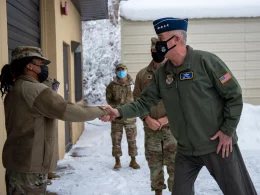NELLIS AIR FORCE BASE, Nev. —
Air Mobility Command recently completed the first iteration of Exercise Bamboo Eagle Jan. 26 – Feb. 3, 2024.
The exercise, a combined event with Air Combat Command, took place in several areas in the Western United States and eastern Pacific Ocean, and built upon fundamentals practiced during last year’s Mobility Guardian 23.
Over 3,000 U.S. service members across four branches and close to 300 of our Allies and partners from the Royal Air Force and Royal Australian Air Force participated in the exercise.
The exercised codified mission fundamentals across the Command to better enable Mobility Air Forces to “Explode into Theater” at a moment’s notice in support of combatant command requirements.
“You don’t get to fight from home station, so you need to be able to very quickly deploy your Airmen and their capabilities forward,” said Lt. Col. Aaron Hines, Bamboo Eagle AMC exercise director. “This disaggregation is so important to practice. This exercise created an operational environment which gave both AMC and ACC the opportunity to explode into theater and create credible threats. It answered questions such as: How do you get out? How do you explode into theater? How do you set the theater for combat?”
BE 24-1 proved global command and control, including crew situational awareness, is crucial to sustaining forward operations. The exercise also allowed crews to practice their ability to rapidly deploy at the furthest node to ensure light, lean, and distributed operations.
As part of the exercise, for the first time, AMC tested a new Global Air Mobility Element concept developed by the 515th Air Mobility Operations Wing. The AME deployment configuration allows rapid disaggregation from a forward hub to spoke locations, putting warfighters further into the fight at a faster rate.
“Over the duration of the exercise, we were responsible for the generation of 95 mobility sorties and the swift movement of 662 passengers and 817,000 pounds of cargo,” said U.S. Air Force Maj. Bryce Grier, 515th AME commander. “We have to provide maximum endurance logistics — to move fast, calculatedly, and lean to maneuver not only ACE packages, but the joint force at large, into and within the Pacific theater,” said Grier.
BE 24-1 also tested AMC’s recent gains in their effort of “25 by ’25,” in which it is their goal to outfit 25 percent of the mobility fleet with distributed command and control capabilities. “This is not about the MAF’s survival, it is about everyone’s survival and our ability to win,” said Gen. Mike Minihan, the AMC commander. “Connectivity investments will increase the survivability, agility, resiliency, and lethality of AMC warfighting capabilities,” he said.
Once connected, an aircraft can receive and make real-time mission changes in flight, enabling them to sense and seize opportunities to deploy, sustain, and maneuver the Joint Force in a contested, degraded, or denied information environment.
To highlight advancements in this initiative, the 305th Air Mobility Wing tested data link integration with the use of Roll-on Beyond Line-of-Site Enhancement, or ROBE kits. A ROBE kit is an advanced communication suite that is self-contained, palletized and able to be loaded onto a heavy aircraft to give crews the ability to receive and provide real-time data transmission to locations on the ground, enable them to divert away from threats and re-route to a different location, and quickly make any changes necessary for survival and to increase lethality.
Additionally, C-17s deployed from Joint Base Charleston to test their ability to “Explode Into Theatre,” specifically with the use of an Airlift Tanker Open Mission System, a roll-on/roll-off kit that interfaces with existing aircraft systems providing Beyond Line of Sight and Line of Sight connectivity.
According to Col David Myrick, 437th Airlift Wing Deputy Commander, the use of ATOMS onboard allowed the fleet to practice distributed control of three separate force elements.
“I approved Acceptable Level of Risk increases, cancellation of training, and approved several mission re-taskings and maintenance decisions, all while in flight,” Myrick said. “Connectivity is a war winning component which enables us to maintain the speed and tempo we need to get inside the adversary’s timeline.”
Lt Col. Daniel Naske, the 14th Airlift Squadron Commander, Joint Base Charleston, further emphasized how connectivity capabilities enabled mission success.
“The 14th Airlift Squadron executed seven simulated palletized effects missions, fully integrating with mission planners and executing in an integrated joint strike package,” Naske said. “Having connectivity on board allows the Tactical Operations Center to recall the formation in the event minimum forces are not met, preventing them from exceeding Acceptable Level of Risk and keeping aircraft and crews safe.”
He offered another example of how connectivity proved to be a game changer.
“Connectivity also allows the aircraft to be dynamically re-tasked in flight,” Naske said. “During the last day of execution, a C-17 executing a simulated palletized effects mission was re-tasked post-vul to land at another airfield and pick up mission-critical cargo they were not initially tasked to pick up, enabling two Joint Force Air Component Commander priority missions.”
Future iterations of this exercise will continue to get after the interoperability of warfighting capabilities against potential aggression and ensure AMC Forces operate with the awareness and connectivity required to win.




